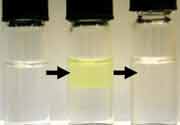Home > Press > Recycling nanoparticles
 |
| Temperature-induced separation and dispersion of cadmium sulphide nanoparticles. Image by Julian Eastoe |
Abstract:
Some nanoparticles are more precious than gold, so being able to recycle them would offer manufacturers important cost savings.
Recycling nanoparticles
UK | Posted on April 28th, 2010Professor Julian Eastoe at the University of Bristol, and colleagues, report the development of a special type of microemulsion - a mixture of oil and water (mayonnaise is an edible emulsion) - that may make it easier for manufacturers to recover, recycle, and reuse nanoparticles.
In laboratory tests using cadmium and zinc nanoparticles, they demonstrate how the oil and water in the microemulsion separated into two layers when heated. One layer contained the nanoparticles that could be recovered and the other contained none.
Importantly, the team reports, the recovered particles retain their shape and chemical properties, which is crucial for their reuse. The new method could speed application of nanotechnology in new generations of solar cells, flexible electronic displays and various other products.
Julian Eastoe said, "Recovering and recycling nanoparticles is especially difficult because they tend to form complex, hard-to-separate mixtures with other substances. We have designed a new kind of solvent which is perfectly suited to nanotechnology.
"A significant advantage of this method over more traditional approaches is that it is much milder on the particles, thereby preserving their structure and stability, and permitting recyclability. Additionally, it allows us to separate and recover the nanoparticles ‘at the flick of a switch', simply by changing the temperature."
This simple process may potentially find applications in cleanup and purification technologies in order to recover, redisperse and reuse valuable nanomaterials. Without this new development, manufacturing processes that take advantage of the unusual properties of nanoparticles might become prohibitively expensive.
The study appears in Langmuir, a bi-weekly journal of the American Chemical Society.
####
For more information, please click here
Copyright © University of Bristol
If you have a comment, please Contact us.Issuers of news releases, not 7th Wave, Inc. or Nanotechnology Now, are solely responsible for the accuracy of the content.
| Related News Press |
News and information
![]() Researchers develop molecular qubits that communicate at telecom frequencies October 3rd, 2025
Researchers develop molecular qubits that communicate at telecom frequencies October 3rd, 2025
![]() Next-generation quantum communication October 3rd, 2025
Next-generation quantum communication October 3rd, 2025
![]() "Nanoreactor" cage uses visible light for catalytic and ultra-selective cross-cycloadditions October 3rd, 2025
"Nanoreactor" cage uses visible light for catalytic and ultra-selective cross-cycloadditions October 3rd, 2025
Academic/Education
![]() Rice University launches Rice Synthetic Biology Institute to improve lives January 12th, 2024
Rice University launches Rice Synthetic Biology Institute to improve lives January 12th, 2024
![]() Multi-institution, $4.6 million NSF grant to fund nanotechnology training September 9th, 2022
Multi-institution, $4.6 million NSF grant to fund nanotechnology training September 9th, 2022
Materials/Metamaterials/Magnetoresistance
![]() First real-time observation of two-dimensional melting process: Researchers at Mainz University unveil new insights into magnetic vortex structures August 8th, 2025
First real-time observation of two-dimensional melting process: Researchers at Mainz University unveil new insights into magnetic vortex structures August 8th, 2025
![]() Researchers unveil a groundbreaking clay-based solution to capture carbon dioxide and combat climate change June 6th, 2025
Researchers unveil a groundbreaking clay-based solution to capture carbon dioxide and combat climate change June 6th, 2025
![]() A 1960s idea inspires NBI researchers to study hitherto inaccessible quantum states June 6th, 2025
A 1960s idea inspires NBI researchers to study hitherto inaccessible quantum states June 6th, 2025
![]() Institute for Nanoscience hosts annual proposal planning meeting May 16th, 2025
Institute for Nanoscience hosts annual proposal planning meeting May 16th, 2025
Announcements
![]() Rice membrane extracts lithium from brines with greater speed, less waste October 3rd, 2025
Rice membrane extracts lithium from brines with greater speed, less waste October 3rd, 2025
![]() Researchers develop molecular qubits that communicate at telecom frequencies October 3rd, 2025
Researchers develop molecular qubits that communicate at telecom frequencies October 3rd, 2025
![]() Next-generation quantum communication October 3rd, 2025
Next-generation quantum communication October 3rd, 2025
![]() "Nanoreactor" cage uses visible light for catalytic and ultra-selective cross-cycloadditions October 3rd, 2025
"Nanoreactor" cage uses visible light for catalytic and ultra-selective cross-cycloadditions October 3rd, 2025
|
|
||
|
|
||
| The latest news from around the world, FREE | ||
|
|
||
|
|
||
| Premium Products | ||
|
|
||
|
Only the news you want to read!
Learn More |
||
|
|
||
|
Full-service, expert consulting
Learn More |
||
|
|
||








